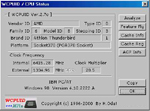Super
Extreme Crazy Overclocking
Part Two
Part Two
![]()
![]()
![]()
I am displaying the same basic story, except from our two points of
view. This is to attempt to avoid "creative differences."
Read both for the full story. keep in mind we didn't collaborate all
that much on these...
Don't try this at home. We are untrained amateurs.
![]()
Dialogue 1
Dialogue 2
Now, since this is an Athlon
Thunderbird we are trying to overclock, we needed to enable the overclocking
function on the chip itself. This is relatively simple, a few exposed
wires on the surface of the chip just need to be connected. Believe it
or not, this can be accomplished with a pencil, the graphite lead conducts
electricity. Then we thought, why not connect a few more for good luck?
Throughout all off this, all I could think of is "Why the heck am
I drawing on a $350 CPU!!!" Just didn't seem like the sort of thing
one ought to do with a high precision computer component. With this done
we kept the case open to improve ventilation.

Now, down to the rest of the
story. We have these pipes going all the way to Canada and coming back.
Pretty cool stuff. Glaciers and all that. There was one problem, however,
we had never overclocked anything like this before. We'd just pumped all
this florinert into Chris' basement and we had to enable part of the processor
before we could actually overclock. So we decided to start playing with
things at random. After all, they couldn't make it so that we could hurt
the thing, right? It was Chris' processor anyway so I convinced him everything
would be fine despite any overwhelming objections that lingered in the
background (and foreground) of my mind.


It
took a "few" minutes for the fluid to really start pumping and
over half a day for the cold stuff to reach us. The room cooled off very
quickly. in less than 4 hours, the room was down to like 30 degrees and
dropping. We decided this was a good time to initiate the benchmarking.
For safety reasons we limited and stays in the "tank" to five
minutes. It was getting juuuust a little cold. Anyway, we turned on the
computer (after tweaking processor speed in BIOS) and started up the benchmarking
program. It was working fairly well, but only the CPU was only hitting
about 1200MHz. This wasn't vary goo, so we modified the setup. The cold
liquid was routed to an area right next to the case, pretty much shooting
right at it. This lowered the temp a bit, now the thing was at around
10 degrees. Needless to say we were dissapointed. And turning blue. And
losing feeling in our limbs.
Thankfully he had a Athlon
Thunderbird 900, so all we had to do to change the clock settings is run
a pencil over part of it. We weren't sure exactly which points to connect
though. Frustrated once more, we remained determined. So we got a pencil
and connected all the dots to all the other dots. It seemed logical that
if you wanted to overclock it some, you connect some dots (or so the other
pages said). If you want to overclock it the most, you connect all the
dots (that's logical right?). Then we thought, maybe if we covered the
the rest in graphite, it would go the fastest it possibly could! Maybe
even faster! So we drew on that thing like it was a circle in a multiple
choice scantron sheet. Fifteen minutes and one processor covered in graphite
later, we started up the computer.
We went out and bought like
50 gallons of liquid helium. Using a top-secret method we circulated the
liquid helium into heat syncs around the processor (it involved hoses).
After getting that sort of circulating we tried again. This time we hit
paydirt. After securing hte heat sync to the CPU a little better we got
some real success (6.4GHz!!!). Just look at the screenshot of the benchmark
program if you don't believe me.


SUCCESS! But still, we had
problems. Not a bad problem, mind you. You see, when the computer booted
up, it didn't have enough room to display the clock speed. When we actually
booted into Windows, we loaded up a benchmark program which told us that
the processor was running at some 6.4 GIGAHERTZ!!! Needless to say we
were very excited. We immediately started up Quake 3 Arena. To our surprise,
we were able to run both the resolution and the bit depth up further than
the monitor could handle. (Further than we thought any monitor could!)
It was great! From what we can figure cooling the processor, motherboard,
hard drive, and the graphics card (A Creative GeForce 2, very nice to
start with anyway) really made a difference. So much of a difference that
we've decided to keep his basement submerged in florinert and work on
developing new, better technologies to play while submerged. We're already
trying to get an old air tank and are working on a more reliable underwater
breathing system (passing out causes some evil headaches). Our helmets
will attach to a sort of airlock that is constantly attached to the monitor.
We just hook the two together and we have a clear view to the monitor
so there's no weird tint. We hope to have a version soon that is flexible
because our necks are getting sore trying out the prototypes that stay
in one spot.
Well, we will probably write more on this in a while, but right now all I will say is that it's freaking COLD!!! I guess liquid helium will do that... So, I'll finish up when I catch up with work and other things.